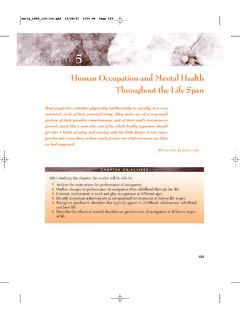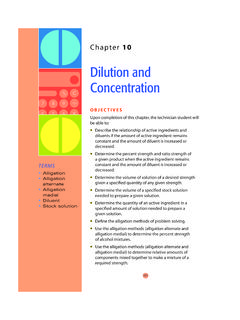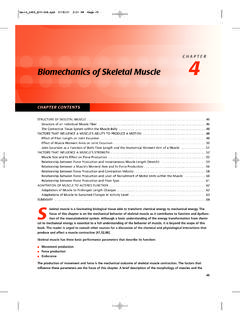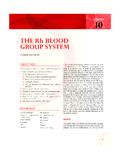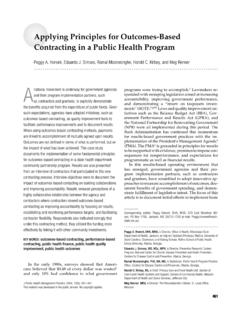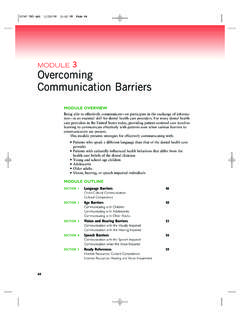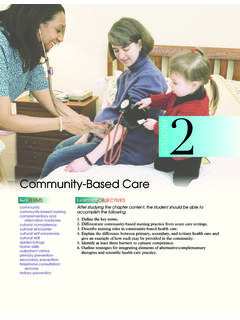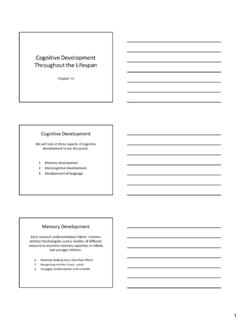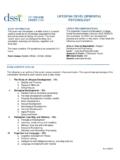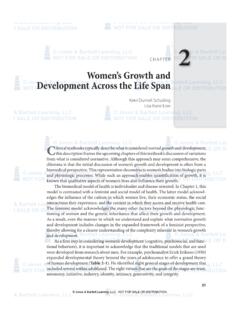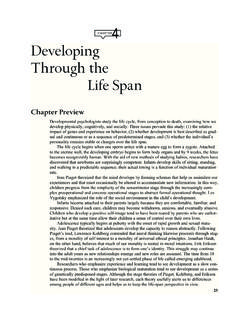Transcription of 11105-03 CH03 REV - Lippincott Williams & Wilkins
1 53 Demonstrate an understanding of human growth and development Explain cognitive development theory List and describe Freud s three major systems or forces Defi ne the reality principle and the pleasure principle List and describe Erikson s eight psychosocial crises Explain the principle of mutuality Defi ne operant conditioning Discuss the impact of reinforcement on behavior Explain the signifi cance of understanding developmental theories as they relate to approaches to communication Demonstrate a basic understanding of the challenges of communicating with each age group Describe a holistic approach to health care communication List communication techniques for working with children Describe communication techniques for working with adolescents Identify communication techniques for working with adults List and describe the therapeutic communication techniques for an older populationChapter 3 COMMUNICATION ACROSS THE LIFESPANBy learning about developmental theories, you ll discover how to communicate more effectively with each patient you development and communication skills change throughout a person s lifespan .
2 As a result, patients of different ages respond to and communicate about their health in different this chapter, you ll learn about human growth and devel-opment. You ll explore the different theories of human develop-ment and behavior as described by Jean Piaget, Erik Erikson, Sigmund Freud, and B. F. Skinner. You ll also learn how these developmental theories affect your work as a health care profes-sional and how you can communicate effectively with patients from all age , development , and Behavior and Its Impact on CommunicationYou might be wondering why it s important to learn about developmental theories and developmental stages.
3 There are three reasons why knowing this information is helpful: It will affect the insights you have about what patients are experiencing. It will affect the way you communicate with patients at various stages of development . It will have an overall impact on your effectiveness as a health care development theories can also help you provide appropriate anticipatory guidance. Anticipatory guidance is infor- Adapt what is said to the recipient s level of comprehension (ABHES Competency ) Instruct individuals according to their needs (CAAHEP Competency ) Be attentive, listen, and learn (ABHES Competency ) Be impartial and show empathy when dealing with patients (ABHES Competency ) Recognize and respond to verbal and nonverbal communication (ABHES Competency , , and ; CAAHEP Competency and )54 Chapter 3 Communication Across the LifespanAlthough Freud s theories are well known, he wasn t the only psychologist to describe human growth and development !
4 In this chapter, you ll explore several different theories that attempt to explain the stages of that helps a child, parent, or guardian understand what to expect as a child grows and develops. It provides information to keep children healthy as they go through different AND development THEORIEST here are many key theories of human growth and develop-ment. No single theory is generally accepted. The theories developed by Piaget, Freud, Erikson, and Skinner have all attempted to describe how humans grow and develop through life. Understanding the basic principles of these theories will improve your communication skills as a medical through THE LIFESPANAs you progress through life, you grow and develop in different ways in response to many factors.
5 All the fac-tors that affect your growth and development can be divided into three groups. Biological factors. These are things that are passed on to you from your parents. The color of your hair and eyes, as well as your height, are some examples of biological factors. Social factors. These are factors related to your relationships, social support, environment, and culture. Your friends, religious community, and cultural traditions all have an effect on your development . Psychological factors. These factors include your self-esteem, how you cope with stress, and how you learn new 1969, Jean Piaget, a Swiss psychologist, developed a theory of cognitive development to help explain human behavior.
6 Piaget used his theory to describe how learning changes from infancy through development LEARNING THEORYC ognitive development refers to the ability to think and reason logically and to learn new ideas. Your cognitive abilities change as you grow. In simple terms, Piaget s theory states that learning is based on interaction with your environment. As a child, you gain Piaget 55 Infants use sensorimotor activities to explore new things in their , learn to solve problems, and begin to understand abstract concepts. This process can be divided into four Sensorimotor activities. From birth to 2 years of age, you interact with your environment using your senses and motor Preoperational thought.
7 From 2 to 6 years of age, you interact with your environment using symbols, basic language skills, and your Concrete operational thought. From 7 to 11 years of age, you interact with your environment using logic and reasoning, other people s perspectives, and abstract Formal operational thought. From the age of 12 years to adulthood, you interact with your environment using a variety of hypothetical, logical, and abstract thought PRINCIPLES OF COGNITIVE development THEORYWhat is cognitive development theory? There are three basic principles of Piaget s theory. New experiences. Each individual makes sense of new expe-riences by somehow connecting them to what is already known.
8 Sequence of development . Every child progresses through each stage of development in the same sequence. The time frames, however, may vary from one child to the next. Other infl uences. Family, culture, personality, and socializa-tion of the sexes may infl uence individual differences in cognitive TO HEALTH CARE PROFESSIONALSU nderstanding Piaget s cognitive development theory will help you communicate more effectively with patients. Use what you have learned about the different periods of cognitive develop-ment to better understand how patients of any age interact with their environment including you!Sigmund FreudAustrian neurologist Sigmund Freud (1856 1939) developed a very different approach to understanding human behavior.
9 Freud s psychoanalytic development theory emphasizes that 56 Chapter 3 Communication Across the LifespanVery small childrencan t control their id impulses. Adults also feel driven by their id forces, but they have learned to control those behavior is strongly affected by certain unconscious development THEORYA ccording to Freud, the basic human drives are survival and reproduction. The forces that guide these drives include hun-ger, thirst, avoidance of pain, and sex. But Freud pointed out that many of these forces are unconscious and hidden from a person s SYSTEMS OF FORCESF reud believed that personality is made up of three basic parts: id ego superegoIdThe id is a person s basic animal nature.
10 It includes basic drives, such as hunger and thirst, and instincts. An instinct is an automatic, natural behavior that does not have to be thought about. The id is mostly unconscious, selfi sh, pain-reducing, and pleasure-loving. It works on the pleasure principle decreasing pain and increasing pleasure. Additionally, the id has very little patience. For example, if you hold a brightly colored toy in front of an infant, the infant will most likely try his hardest to grab the toy out of your hands. According to Freud, very small children are directed only by id forces. The baby does not think to ask permission for the toy.
